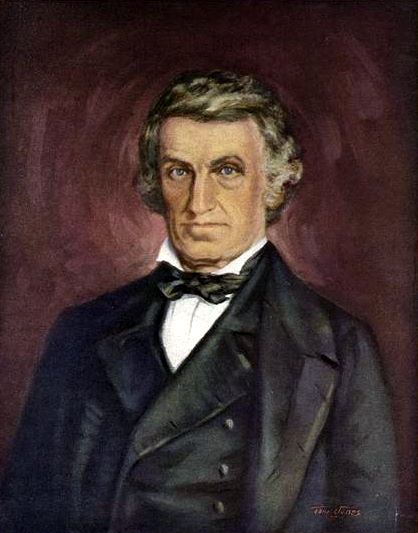<Back to Index>
- Surgeon William Beaumont, 1785
- Writer François Marie Arouet (Voltaire), 1694
- Member of the Politburo Mikhail Andreyevich Suslov, 1902
PAGE SPONSOR

William Beaumont (November 21, 1785 – April 25, 1853) was a surgeon in the U.S. Army who became known as the "Father of Gastric Physiology" following his research on human digestion.
William Beaumont was born to Samuel and Lucretia Abel Beaumont in Lebanon, Connecticut. In 1811 William trained to become a doctor through an apprenticeship with Dr. Truman Powell in St. Albans, Vermont. From 1812 until 1815, Beaumont served as a surgeon's mate in the army during the War of 1812. After the war ended he started a private practice in Plattsburgh, New York, but by 1819 Beaumont had rejoined the army as a surgeon. He was assigned a location at Fort Mackinac. Beaumont took a leave in 1821, and married Deborah Green Platt in Plattsburgh, before returning to his post. Deborah was divorced from Nathaniel Platt, whose uncle Zephaniah Platt founded Plattsburgh after the beginning of the Revolutionary War.
On June 6, 1822, an employee of the American Fur Company on Mackinac Island, named Alexis St. Martin, was accidentally shot in the stomach by a discharge of a musket loaded with a duck shot from close range that injured his ribs and his stomach. Dr. Beaumont treated his wound, but expected St. Martin to die from his injuries. Despite this dire prediction, St. Martin survived - but with a hole, or fistula, in his stomach that never fully healed. Unable to continue work for the American Fur Company, he was hired as a handyman by Dr. Beaumont.
By August 1825, Beaumont had been relocated to Fort Niagara in New York, and Alexis St. Martin had come with him. Beaumont recognized that he had in St. Martin the unique opportunity to observe digestive processes. Dr. Beaumont began to perform experiments on digestion using the stomach of St. Martin. Most of the experiments were conducted by tying a piece of food to a string and inserting it through the hole into St. Martin's stomach. Every few hours, Beaumont would remove the food and observe how well it had been digested. Beaumont also extracted a sample of gastric acid from St. Martin's stomach for analysis. In September, Alexis St. Martin left Dr. Beaumont and moved to Canada, leaving Beaumont to concentrate on his duties as an army surgeon. Beaumont also used samples of stomach acid taken out of St. Martin to "digest" bits of food in cups. This led to the important discovery that the stomach acid, and not solely the mashing, pounding and squeezing of the stomach, digests the food into nutrients the stomach can use; in other words, digestion was primarily a chemical process and not a mechanical one.
During 1826 and 1827, Dr. Beaumont was stationed at Fort Howard in Green Bay, Wisconsin. In 1828 he was transferred to St. Louis, Missouri. While en route to St. Louis, Beaumont was ordered to stop at Fort Crawford in Prairie du Chien, Wisconsin to
serve as his handyman again. In early 1831, Dr. Beaumont conducted
another set of experiments on St. Martin's stomach, ranging from the
simple observation of normal digestion to the effects that temperature,
exercise and even emotions have on the digestive process. Beaumont left the army in 1832 and moved to Washington, D.C.
There he met St. Martin once again, and performed another set of
experiments on how various foods were digested in the stomach. In 1833,
Beaumont returned to Plattsburgh where he wrote a book about his
experiments on digestion titled Experiments and Observations on the Gastric Juice and the Physiology of Digestion. St. Martin returned to Canada during the spring of 1833, and would
never see Dr. Beaumont again, although he corresponded with the
Beaumont family; St. Martin died in 1880. In
1834, Beaumont reenlisted and was stationed at St. Louis. He left the
service in 1839, and maintained a private practice in St. Louis until
his death in 1853. Beaumont is buried in Bellefontaine Cemetery St. Louis, Missouri.